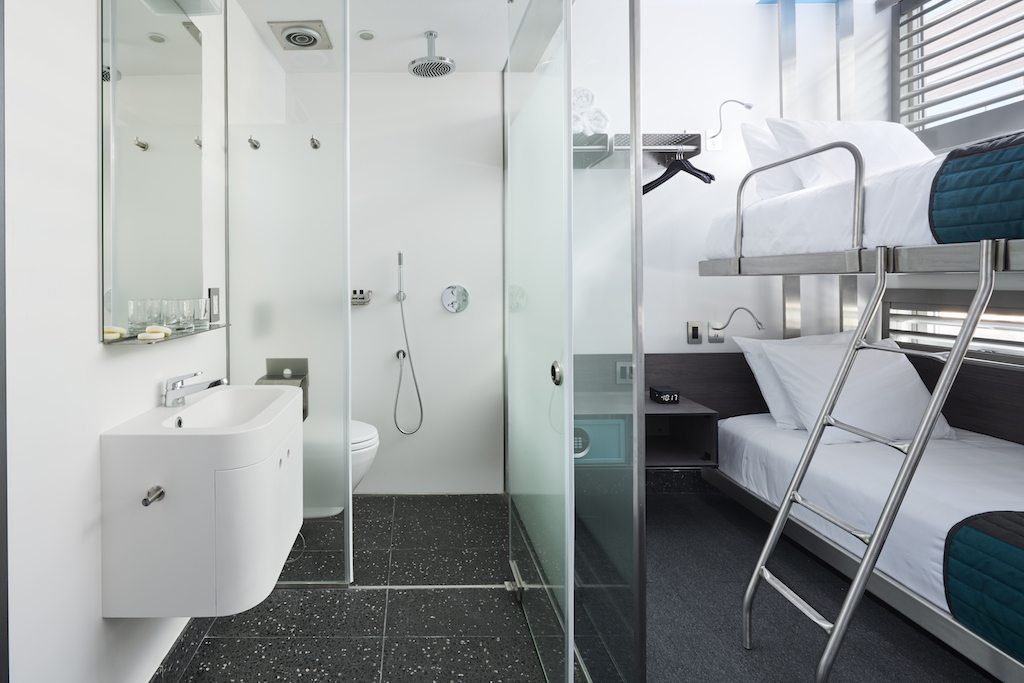Pod Hotels Owner Is Thinking Small to Grow Big

Skift Take
BD Hotels co-founder Richard Born is very busy these days. While the boutique hotel company he started with Ira Drukier is perhaps best-known for its luxury and upscale properties, including The Mercer Hotel, Hotel Elysee, The Jane, and the Greenwich Hotel, BD Hotels is now focusing on growing its first brand, Pod Hotels.
"It's the first thing we've ever done two of," Born said. "I sensed the demand to repeat ourselves after we opened the first Pod in 2007."
The hotels are known primarily for the diminutive sizes of their rooms and thus the name, Pod Hotels. Rooms at the original East 51st Street location in New York City start at just 72 square feet, and at the East 39th Street location, they begin at 90 square feet.
"These aren't small rooms that are cheap," Born said. "The materials we use are very high-end and we've designed the rooms in a meaningfully important way. You're sacrificing space, not quality. There's a niche in the marketplace of people who want high quality and design but also want a boutique feel."
Today, there are three Pod Hotels locations — two in New York and one that recently opened in Washington, D.C. And soon, BD Hotels will open an additional two locations in New York: one in Brooklyn's Williamsburg neighborhood, and another in the heart of Times Square. The company is also planning to open a Pod Hotel in downtown Los Angeles by spring 2019.
BD Hotels' Pod Hotels aren't alone in terms of capitalizing on the small guest-room trend. In New York City alone there's also Yotel, with its futuristic designs and rooms measuring around 170 square feet. Newcomer Arlo Hotels has rooms measuring no more than 165 square feet. And in early June, famed boutique hotelier Ian Schrager opened his new flagship Public New York Hotel with guest rooms ranging in size from 205 to 220 square feet.
Why You'll See Even More Micro Hotels Going Forward
Born said the success he's seen with his Pod Hotels has convinced him to grow the brand even more.
"Two-thirds of the hotels in the U.S. are three-star branded corporate environments, but we've asked ourselves, wouldn't people want to stay in a smaller space with more style? Everyone just wants to find themselves in a smarter environment and we're outperforming out competitors in the same price range." Rack rates for Pod Hotels in New York range from $100 to $250 a night.
Born said that for his two New York City-based Pod Hotels, occupancy rates are, on average, hovering around 94 percent every night.
Bjorn Hanson, clinical professor with the NYU Preston Robert Tisch Center for Hospitality and Tourism, said that micro hotel rooms "make a lot of sense for a couple or reasons." Hanson said that, as far back as 40 years ago, traditional hotel rooms measured, on average, 375 square feet but today, sizes have shrunk slightly to 325 square feet.
Today's micro hotel rooms, however, are in the 180-square-foot range, and they allow developers to build a third more number of rooms, without having to charge nightly rates that are a third lower in price. Instead, those nightly rates are anywhere from 15 to 25 percent lower. "If you compare the investment costs relative to slightly lower revenue the economics are favorable," Hanson noted.
Not only that, but more guests want to spend more time in lobbies, regardless of their age. Today's hotel lobbies are no longer reserved for checking in and checking out. They are places for "entertainment, communal tables, virtual concierge walls, giant televisions, local artists and exhibits and tastings," said Hanson.
"All categories of guests are spending less time in their hotel rooms compared to 40 years ago," Hanson said. "The rooms are more functional as a place to sleep and bathe. Many of these new concepts don't even have desks. People are working on their laps. The nature of the use of the rooms is requiring less square footage."
Makarand Mody, assistant professor of hospitality marketing at Boston University's School of Hospitality Administration said he likewise sees these types of hotels appealing to guests who don't want to spend the majority of their days in their hotel rooms.
"The type of person these hotels would cater to are those that like to spend more time outside of the room itself," Mody said. "The rise of this experience-seeker has been well-documented in several Skift articles and reports. The room and a comfy bed are simply a place to come back to after a day of experiences, which is why many of these micro-room hotels offer interesting public spaces with innovative dining and social options. So why not make the rooms smaller, but more efficient, and instead provide more to do within the hotel but outside of the room?"
Hanson echoed what Born said about people wanting a different kind of hotel experience. "There are television shows about tiny houses now, for example," he said. "This whole idea of it being a style trend is very interesting with the design challenges and opportunities. There's subtlety of small as having some appeal and finally, travelers are looking for an experience. The traditional 325 square-foot hotel room with a typically configured bathroom and lobby are fine for some things. But for those looking for an experience, they want to see how architects and designers create a type of experience given these space constraints."
To that end, Hanson is optimistic that Schrager will see success with his new Public New York hotel.
"What he's doing, again, is finding ways to redefine the hotel experience from a guest's point of view," Hanson said. "When I used to do site visits with Ian, which I haven't done for decade, we'd walk into a big space and he'd always ask, 'How would a guest respond to this as a lobby? What would a guest feel when walking into the space?' He was the first person to really create a lobby scene."
With Public, Hanson said he thinks Schrager is "saying that the definition of luxury has changed."
Luxury is no longer defined by concierges or turndown service. "There are people who are looking for some of the elements of luxury, a level of service and support and some higher quality finishes and designs, but different from the traditional. It's a more everyday version of the definition of luxury. …
"Instead of staying in a more traditional select-service hotel, this is a designed-for-me version of luxury. Whether people pay a little more for this aspirational product Ian is created is all but certain. People have understood what select service means. Can he deliver a luxury version of that, which is almost an oxymoron? I think the answer is yes."
Mody also noted that by making rooms smaller and focusing on the guest experience outside of the room, Schrager has "more revenue-enhancement opportunities." "Look at the Public Arts space at the Public New York, for example," he said. This multi-purpose space can be used for performances, as a nightclub or lounge, or an event space.
"And with travelers looking for more unique and local dining and social experiences, the hotel can move from being a provider of rooms to a curator of the best experiences, all within the hotel itself," Mody said.
What's Powering Pod Hotels' Growth
An added benefit for hotel developers is that micro-hotel rooms can be environmentally friendly and have a smaller carbon footprint and require less energy consumption. They also cost less for developers to build.
At Pod Hotels, Born is using modular construction methods to build his two newest properties in New York. The 250-room Williamsburg, Brooklyn hotel, Pod BK, will be four stories and was built in as a little as 26 days. It is scheduled to open in September.
The 670-room Times Square location, known as Pod Timesquare, will have 45 "Pod Pads" that Born described as "plug-and-play" apartments that are not necessarily "cheaper, but are more convenient."
It's not extended stay, Born said. "Real estate [in New York] is precious here, and we think you can live in half the space."
Both the Brooklyn and Times Square locations will have a much larger percentage of rooms with bunk bed configurations. While the first two Pod hotels only had 20 percent of rooms with bunk beds, these two will now offer 40 percent.
Hanson, for one, thinks this is an economically sound strategy for Born to consider because having a diversification of accommodations simply makes good business sense.
It allows "guests to self-select what supply segment of types of hotels are most responsive to their individual trip needs," Hanson said.
Gone are the days of the purely leisure or business traveler — those categories have become "irrelevant," he said. "All of these demand segments have merged and changed so much. Every trip for every guest is a unique demand segment, so it's better for the guest and can create much better economics for the hotel industry."
The hotel market in New York City seems to be saturated and it is Airbnb's second largest market in the world.
When asked if investing so heavily in New York City makes sense, Born said he's thinking long term. "Tourism in New York has grown by 45 percent every year for the last 25 years with the exception of 2009," he said. "Everyone in the world wants to come to New York City."




